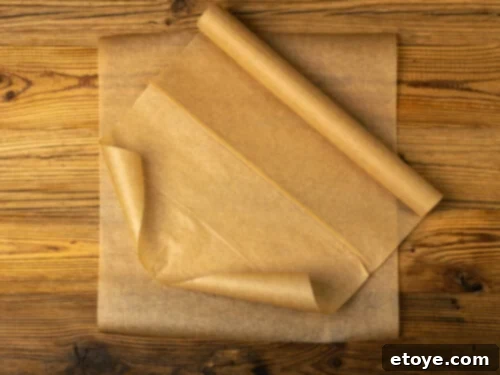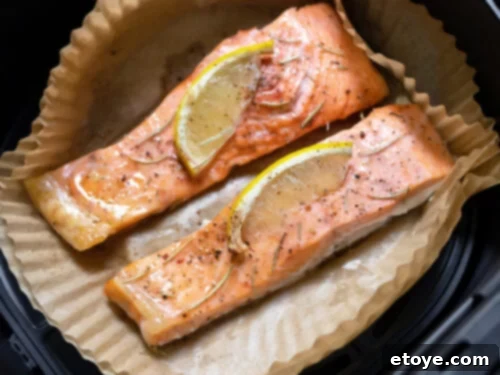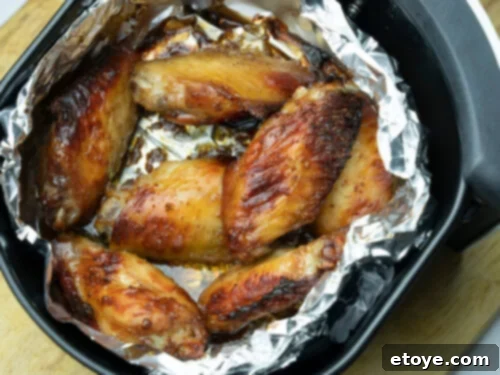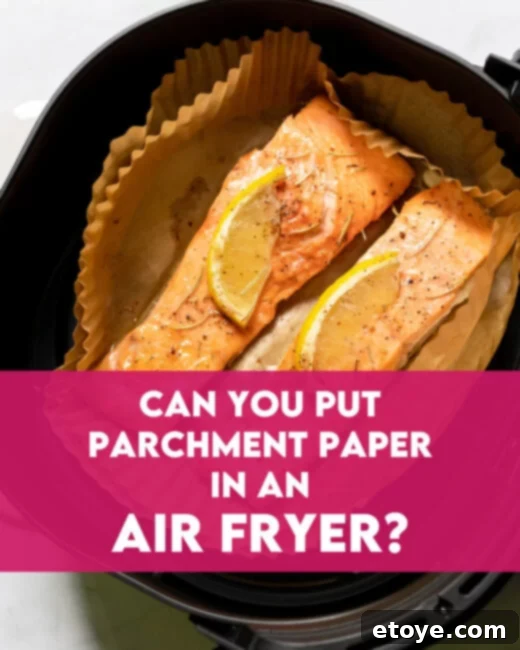The air fryer has quickly become a kitchen staple for countless households, revolutionizing the way we enjoy our favorite dishes. This ingenious appliance promises crispy, delicious results with significantly less oil, making healthier eating more accessible and convenient than ever. As you explore the culinary possibilities with your air fryer, a common question often arises: “Can I use parchment paper in my air fryer?” This seemingly simple query touches upon both convenience and safety, as home cooks seek ways to simplify cleanup and prevent food from sticking.
Using parchment paper in an air fryer offers enticing benefits, such as a non-stick surface that makes for effortless cleanup and keeps your appliance in pristine condition. However, it’s crucial to understand the nuances of its use to ensure both safety and optimal cooking performance. Improper use can lead to issues ranging from ineffective cooking to potential fire hazards.
This comprehensive guide will deep dive into everything you need to know about using parchment paper in your air fryer, whether you’re considering air fryer-specific liners or standard baking parchment. We’ll cover the ‘do’s and don’ts,’ explore the differences between various kitchen papers, and provide essential tips to enhance your air frying experience. By the end of this guide, you’ll be equipped with the knowledge to safely and effectively incorporate parchment paper into your air frying routine, keeping your meals delicious and your cooking process smooth.

Unveiling the Magic of Air Fryers
Before we delve into parchment paper specifics, let’s take a moment to appreciate the star of our kitchen — the air fryer. This trendy countertop appliance has transformed the way many approach “fried” foods, offering a guilt-free alternative to traditional deep-fat frying. Understanding how it works is key to maximizing its potential and using accessories like parchment paper effectively.
The Ingenious Technology Behind Air Fryers
- Convection Cooking Power: At its core, an air fryer is a compact convection oven. It features a powerful heating element and a high-speed fan that rapidly circulates hot air around your food. This superheated air envelops every surface, creating a crispy exterior that mimics deep frying, but with only a fraction of the oil. Think of it as a mini wind tunnel for your food, ensuring even cooking and a delightful crunch.
- Superior Air Circulation: The design of an air fryer, particularly its perforated basket, is engineered for optimal air circulation. This consistent flow of hot air is paramount for achieving that signature crispy texture. Unlike a conventional oven where hot air can stagnate, the air fryer’s fan constantly moves the air, quickly dehydrating the food’s surface and promoting browning. This method also significantly speeds up cooking times compared to traditional ovens, making it perfect for quick meals and busy weeknights.
The Myriad Benefits of Air Frying
- A Healthier Culinary Choice: One of the most significant advantages of air frying is its contribution to healthier eating. By using minimal to no oil, air fryers dramatically reduce the fat and calorie content of your favorite “fried” dishes. You can savor crispy chicken wings, golden French fries, and perfectly roasted vegetables with far less guilt, making it an excellent tool for health-conscious home cooks.
- Unmatched Versatility: Don’t let the name “air fryer” limit your imagination. These appliances are incredibly versatile. Beyond classic fries and chicken, an air fryer can roast a variety of vegetables to perfection, bake small cakes and muffins, reheat leftovers to their original crispness, and even cook delicate fish fillets or juicy steaks. Its capabilities extend far beyond what many initially expect, making it a true multi-tasker in the kitchen.
- Ultimate Convenience and Enhanced Safety: Compared to the splattering oil and potential hazards of deep frying, air fryers offer a cleaner and safer cooking experience. There’s no large pot of hot oil to manage, reducing the risk of burns. Cleanup is often much simpler, especially when using liners. Furthermore, their rapid preheating and cooking times contribute to a more convenient meal preparation process, fitting seamlessly into modern lifestyles.

Deciphering Parchment Paper: Your Kitchen’s Non-Stick Hero
Parchment paper, often overlooked, plays a crucial role in modern cooking and baking, primarily known for its remarkable non-stick properties and heat resistance. Before we integrate it into our air frying adventures, let’s understand what makes this kitchen staple so effective and how it compares to other common alternatives.
What Exactly Is Parchment Paper?
- The Non-Stick Champion: Parchment paper is a cellulose-based paper that has been treated with a thin layer of silicone. This silicone coating is what gives it its exceptional non-stick qualities, making it ideal for lining baking sheets, cake pans, and now, air fryer baskets. It prevents food from adhering to surfaces, ensuring easy release and significantly simplifying cleanup. Its smooth, slightly waxy feel (though it contains no wax) is characteristic of its silicone treatment.
- Built for High Temperatures: A key feature of good quality parchment paper is its ability to withstand high temperatures without scorching or burning. Most brands are rated to safely handle temperatures up to 428°F (220°C). This heat resistance is vital for oven and air fryer use, where temperatures can soar. Always check the maximum temperature limit specified on the packaging of your specific parchment paper brand, as limits can vary slightly. Exceeding this limit can cause the paper to brown, become brittle, or even ignite.
Parchment Paper vs. Other Kitchen Materials
- Parchment Paper vs. Wax Paper: A Critical Distinction: It’s a common mistake to confuse parchment paper with wax paper, but the difference is critical, especially when heat is involved. Wax paper is coated with a thin layer of soybean or paraffin wax. While excellent for wrapping sandwiches, separating food items, or lining pans for no-bake goods, wax paper is absolutely *not* heat-resistant. When exposed to high temperatures in an air fryer or oven, the wax will melt, smoke, and can easily catch fire, posing a serious safety hazard. Always confirm you are using parchment paper for any heat-related cooking.
- Parchment Paper vs. Aluminum Foil: Aluminum foil is another ubiquitous kitchen item often used for lining or wrapping. It can be used in an air fryer, but with specific precautions. Foil is excellent for structural support (like making a pouch for fish or vegetables) and can create a barrier for messy foods. However, it’s crucial to ensure aluminum foil does not restrict the air fryer’s essential airflow or come into direct contact with the heating element, which could damage the appliance or pose a fire risk. Additionally, highly acidic foods (like tomatoes or citrus) can sometimes react with aluminum foil, potentially affecting the food’s flavor.
- The Rise of Perforated Parchment Paper Liners: Recognizing the growing popularity of air frying, many manufacturers now offer perforated parchment paper liners specifically designed for air fryers. These come pre-cut in various sizes to fit standard air fryer baskets and feature small holes. These perforations are ingeniously designed to facilitate crucial air circulation within the air fryer, ensuring even cooking and crispiness, while still providing the non-stick benefits and easy cleanup of regular parchment paper. They are often hailed as the best option for air fryer users seeking convenience and optimal results.

Can You Put Parchment Paper in an Air Fryer? The Definitive Guide
The short answer is a resounding yes! You can indeed use parchment paper in your air fryer, and it can significantly enhance your cooking experience. However, its effective and safe use depends entirely on understanding the right techniques and precautions. Let’s explore the benefits, best practices, and important safety considerations.
The Undeniable Benefits of Using Parchment Paper in Your Air Fryer
- Effortless Non-Stick Surface: One of the primary advantages of parchment paper is its superior non-stick quality. This is a game-changer for foods prone to sticking, such as delicate fish fillets, cheesy snacks, or marinated meats. The paper ensures that your food cooks beautifully without tearing apart or leaving stubborn residue on the air fryer basket, making food transfer a breeze.
- Preserving Your Air Fryer Basket: Parchment paper acts as an effective barrier, shielding your air fryer’s non-stick mesh basket from sticky residues, burnt-on bits, and grease. This protection not only simplifies cleanup but also helps to extend the lifespan of your basket’s non-stick coating by minimizing the need for harsh scrubbing, thereby preventing wear and tear.
- Preventing Flavor Transfer: For home cooks who prepare a variety of dishes, parchment paper can be a handy tool for preventing flavor transfer. If you’ve just cooked garlic-heavy chicken wings and want to make a batch of sweet potato fries, a fresh piece of parchment paper can help ensure the flavors don’t mingle in the basket, keeping each dish tasting distinct and fresh.
Best Practices for Using Parchment Paper in Air Fryers
- Precision Sizing is Paramount: The size of your parchment paper is not merely a suggestion; it’s crucial for optimal air fryer performance. Always cut or select a parchment liner that is slightly smaller than the bottom of your air fryer basket or tray. This ensures that the essential hot air circulation, which is the heart of how an air fryer works, is not obstructed. A properly sized liner allows air to flow freely around and under the food, promoting even cooking and crispiness.
- Perforating for Enhanced Airflow: If you’re using standard parchment paper and don’t have pre-perforated liners, take a moment to make some holes. Using a toothpick, skewer, or even a hole punch, create a pattern of small holes across the paper. These perforations are vital; they allow hot air to circulate more effectively around the food and enable any excess grease or moisture to drain away, contributing to crispier results.
- Avoid Overcrowding the Basket: While it might be tempting to maximize space, stuffing your air fryer basket with overly large pieces of parchment paper or too much food is counterproductive. Overcrowding restricts air circulation, leading to unevenly cooked food that lacks crispiness. Always ensure there’s ample space for air to move freely around both the food and the parchment paper for best results.
- Embrace Custom Air Fryer Liners: For ultimate convenience and safety, consider investing in custom-made air fryer liners. These are specifically designed parchment paper circles or basket-shaped liners that are pre-perforated and sized to fit standard air fryer baskets. They resemble oversized coffee filters but are made from heat-resistant parchment paper. Available on Amazon and in most major grocery stores, these liners eliminate the guesswork of sizing and perforating, making your air frying experience even smoother.
Critical Safety Tips and Potential Risks
- Respect the Heat Limit: While parchment paper is heat resistant, it’s not invincible. Most brands are safe up to 428°F (220°C). Always double-check the maximum temperature restriction printed on the box. Exceeding this limit can cause the paper to scorch, become brittle, or even ignite, especially if left empty in a very hot air fryer.
- The Danger of Floating Paper: This is arguably the most important safety rule. Never preheat your air fryer with an empty piece of parchment paper inside. The powerful fan will cause the lightweight paper to lift and float around, potentially coming into direct contact with the heating element. This can cause the paper to smoke, burn, or even catch fire. Always place the parchment paper into the air fryer basket *after* preheating, and immediately weigh it down with food to keep it securely in place.
- Consider Safe Alternatives: While parchment paper is a great option, other safe alternatives exist. Reusable silicone mats designed for air fryers are becoming increasingly popular. They offer similar non-stick benefits, are eco-friendly, and can withstand high temperatures. Ensure any silicone mat you use is explicitly rated for high heat and is the correct size for your air fryer to maintain proper airflow.
When to Strategically Use Parchment Paper
- Ideal for Messy or Sticky Foods: Parchment paper is your best friend when cooking items that are prone to sticking to the basket or leaving a difficult-to-clean residue. This includes marinated chicken wings, breaded items like fish sticks or mozzarella sticks, cheesy snacks, delicate fish with skin, or anything with a sugary glaze. It minimizes direct contact and simplifies post-cooking cleanup.
- Think Twice for Lighter Foods: For very light, small food items that don’t require a non-stick surface, you might want to skip the parchment paper. Items like broccoli florets, kale chips, or popcorn can be light enough to potentially shift the parchment paper during cooking, even when weighted down, potentially disrupting airflow and cooking efficiency.

FAQ: Demystifying Air Fryers and Parchment Paper
Still have lingering questions about making the most of your air fryer and parchment paper? Here are answers to some of the most common queries, providing clarity and further insights for your culinary adventures.
Q: Can I use tin foil instead of parchment paper in my air fryer?
A: Yes, aluminum foil is a viable and common alternative to parchment paper in air fryers. It’s particularly useful for foods that need more structural support, like wrapping fish or making a small pouch for vegetables. Foil can also create a tighter seal for steaming or roasting certain items. However, remember to ensure that the foil doesn’t block crucial airflow or come into direct contact with the heating element. Also, be mindful that highly acidic foods may react with aluminum foil, potentially affecting flavor.
Q: Is it necessary to use cooking spray in my air fryer?
A: Cooking spray isn’t always strictly necessary, but it can significantly contribute to achieving the best results, especially when you’re not using parchment paper or tin foil. A light spray of oil can help prevent foods from sticking to the basket and is essential for achieving that desirable golden-brown and crispy texture. When using cooking spray, opt for a pump sprayer with your own oil or a non-aerosol spray, as aerosol sprays (like Pam) can contain propellants that may damage the non-stick coating of your air fryer basket over time.
Q: What’s the main difference between parchment paper and baking paper?
A: The terms ‘parchment paper’ and ‘baking paper’ are very often used interchangeably, and in many regions, they refer to the same product: a silicone-treated paper designed for heat resistance and non-stick properties. However, it’s always wise to check the packaging. True parchment paper is specifically treated for high heat resistance, making it suitable for both oven and air fryer use. If a product is simply labeled “baking paper,” confirm its heat rating to ensure it meets the requirements for your cooking method.
Q: For best results, should I preheat my air fryer before using parchment paper?
A: Preheating your air fryer is generally recommended to ensure better and more consistent cooking results, as it allows food to start cooking immediately at the desired temperature. However, if you are using parchment paper, it is crucial to place it into the air fryer basket *only after* the preheating cycle is complete and just before adding your food. This prevents the lightweight parchment paper from being lifted by the powerful fan and potentially coming into contact with the heating element, which poses a significant fire risk.
Q: Are air fryers a better option for health-conscious home cooks?
A: Absolutely. Many nutritionists and home cooks consider air fryers a healthier alternative to traditional deep frying. By utilizing hot air circulation rather than submersion in oil, air fryers can produce deliciously crispy food with significantly less added fat and calories. This allows individuals to enjoy their favorite “fried” dishes in a much healthier way, making it an excellent appliance for anyone looking to reduce their fat intake without sacrificing flavor or texture.
Q: How do I clean my air fryer basket if I don’t use parchment paper?
A: If you don’t use parchment paper, cleaning your air fryer basket often involves soaking. After letting the basket cool, remove any large food debris. Fill the basket with warm, soapy water and let it soak for 15-30 minutes. This helps loosen any stuck-on food. Then, use a soft sponge or non-abrasive brush to gently scrub the basket. Avoid harsh scrubbers or metal utensils, as these can damage the non-stick coating. Rinse thoroughly and dry completely.

Wrapping Up Our Air Fryer Adventures
As we conclude our deep dive into the world of air frying and parchment paper, it’s clear that this dynamic duo offers a fantastic way to elevate your cooking experience. Air fryers have truly revolutionized kitchen routines, providing a healthier, faster, and more convenient method to achieve that coveted crispy perfection for a wide array of dishes. And when paired correctly, parchment paper becomes an indispensable tool, simplifying cleanup and protecting your beloved appliance.
Remember the key takeaways: always use heat-resistant parchment paper, ensure it’s properly sized and weighted down by food to prevent it from floating, and consider pre-perforated liners for optimal airflow and ease. By following these simple yet crucial guidelines, you can confidently unlock the full potential of your air fryer, enjoying delicious, perfectly cooked meals with minimal fuss.
But the journey of culinary discovery never truly ends! We believe that the best kitchen tips and tricks often come from fellow home cooks. If you’ve discovered a brilliant air fryer hack, a creative way to use parchment paper, or a mouth-watering recipe that leverages these insights, don’t keep it to yourself! Dive into the comments section below and share your wisdom. Your experience could be the missing ingredient someone else needs to transform their next air fryer feast. Happy air frying!
